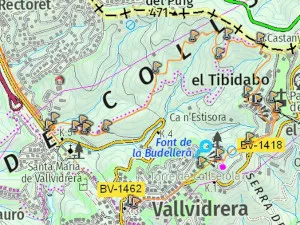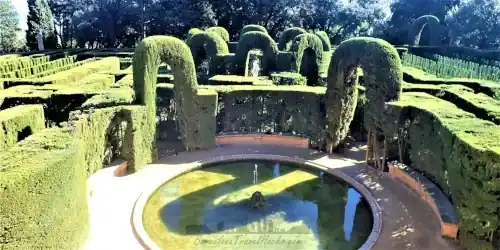
Sant Cugat Monastery and Wine Cellar near Parc Colserolla
Walled monastery & church museum. The wine co-operative was founded in 1921 by 50 local wine makers as a place to process the grapes
About Sant Cugat Monastery and Wine Cellar
Sant Cugat monastery
Dates from the ninth century. in the year 985 it was damaged by an attack of Muslim troops led by al-Mansur Ibn Abi Aamir who repaired the monastery and added the minaret which remains today.
In the mid-12th century, the construction of a new monastery began. It was finished in 1337. In 1350, work began on the fortifications. During the War of Spanish Succession (1701-1714), it was occupied by troops of Archduke Charles, causing damage to the structure. Restoration work was completed in 1789. In 1835, the monastery was abandoned by the monks, remaining empty until 1851, when restoration began. It was declared a National Monument in 1931.
Distinctive features of the monastery are is two floor cloister, Church and walled compound. The 30 metre cloister was designed by Arnau Cadell and his disciple Lluis Samaranch and follows the square plan typical of many monasteries in Catalunya from this period.
The cloister is Romanesque but the church is built in the Gothic style, having a nave and two aisles. The façade has a large (8.2 metre diameter) rose window, similar to those in the Cathedrals of Barcelona and of Tarragona. The church houses a Gothic altarpiece, known as the retablo de Todos los Santos, made in 1375 by Pere Serra.
Sant Cugat Wine Cooperative
In 1921, fifty-one local viticulturists, some of them owners, but mostly tenants, founded the Sindicat Vitivinacola and Caixa Rural de Sant Medir, a cooperative whose main objective was to make wine together to get more out of the production of grapes. It was commissioned from Cesar Martinell, the architect specialising in agrarian modernist architecture of the time.
After the peek of 1950 when maximum production was reached activity began to gradually decline. The crisis in the sector had a very important impact, but above all the fact that the rural Sant Cugat that until then lived from the work of the field was already beginning to be transformed into a city.
Image Gallery For Sant Cugat Monastery and Wine Cellar
Click on any of the 38 images to open full screen gallery player. Note that viewing images is subject to our Fair Use Policy.
Visiting Sant Cugat Monastery and Wine Cellar
Allow 4 to 6 hours to complete the hiking route from Sant Cugat to Barcelona.
I recommend taking 2 to 3 litres of drinking water.
Sant Cugat Monastery
Due to the monastery being abandoned by the monks, most of the relics have been long since removed so inside there are few artefacts. However the space has been preserved and converted into a museum with exhibitions about the history and monastic life. For opening hours and prices check the website.
When I visited on a Sunday morning, I got in for free but this did not include an audio guide.
- Opening Hours of Sant Cugat Monastery:
- Tuesday to Saturday: 10:30h to 13:30h & 16:00h to 19:00h (1st of June to 30th September till 20:00h)
- Sunday and public Holidays: 10:30 to 14:30h
- Closed: Monday, 1st & 6th January, 25 & 26th December
Sant Cugat Wine Cooperative
The last vinification took place in 1988, and the other agricultural services were gradually closed. The auxiliary buildings, and in 1994 the ships of the vats, began to be demolished to give way to a new housing block. The room for the reception of grapes and wine making, built in 1921 according to Martinell's project, was ceded by the cooperative to the city. Rehabilitated and turned into a museum, today it is one of the Museums of Sant Cugat.
- Opening Hours of Sant Cugat Wine Cooperative:
- Saturday: 10:30h to 13:30h & 16:00h to 19:00h (1st of June to 30th September till 20:00h)
- Sunday and public Holidays: 10:30 to 14:30h
- Closed: Monday to Friday, 1st & 6th January, 25 & 26th December
This is free to enter but has limited opening times.
Hiking from Sant Cugat to Barcelona with a Dog
You will have to leave tour dog tied up outside if you viit the interior of the monastery. The wine co-operative is open air and I doubt that there would be any objection to entering with a dog.
The trees are mostly oak and cork with some pines so in summer and spring there may be poisonous Pine Processionary Caterpillars.
These paths are wide lanes and popular with cyclists so ensure your dog is ok with this and not startled. Occasionally you may find Horse riders on the trail.
Calçotada in Restaurant Can Borell
This is a good spring Calçotada hike when started at 9 in the morning and arriving at restaurant can Borell at 14h to 15h for the Calçotada set menu.
Calçots are milder and less bulbous than onions and have a length of between 15 and 25 cm (white part) and a diameter of 1.7 to 2.5 cm at the root. Planted in trenches, like an onion, as a single bulb, and successively increasing the depth of the soil around the stems throughout autumn and winter. They sprout into 4-10 shoots, roughly the shape of small leeks or scallions.
The origin of the Calçot and its cooking method is in the town of Valls, Catalonia, Spain, where an annual event celebrates the harvest of Calçot. Nowadays, thousands of eating gatherings centred around the Calçot, called Calçotada, are celebrated around Catalonia.
Calçot are harvested in early spring / late winter and served in Calçotadas in many of the rural and city restaurants in Catalunya. In these events, they are grilled over a hot fire, wrapped up in newspaper, served on terra cotta tiles and eaten, after peeling with bare hands, by dipping them one by one in salvitxada sauce (sauce made with almonds, garlic, tomatoes and olive oil).
At a Calçotada you are served with a bib, gloves and wet wipes because eating them the traditional way is a messy but fun affair.
What to take with you for Sant Cugat Monastery and Wine Cellar
This is a short walking route not far from roads so I always do it with a small rucksack of the essentials. Emergency waterproof jacket is optional depending on the weather forecast.
1 - 2 litres of water because there are fountains along the route.
Tickets for Sant Cugat Monastery and Wine Cellar
Getting to Sant Cugat Monastery and Wine Cellar
Address: Plaza d Octavia, Sant Cugat del Valles, 08172
If you just want to visit the Monastery and wine cellar then you can get the FGC from Plaça Catalunya to FGC Sant Cugat on the Valles lines.
I have a walking route of 13km through Parc Collserola starting at Sant Cugat FGC station and ending up at Vall de Hebron green (L3) metro station in Barcelona.
Because all these stations are in Zone-1, use a T-Casual or Hola-Barcelona travel card for metro, bus and FGC Train services.
Documents for Sant Cugat Monastery and Wine Cellar
Wikiloc Trail for Sant Cugat Monastery and Wine Cellar

Please sign in with Google to view the Wikiloc Route map.
Sign in with GoogleWeather for Sant Cugat Monastery and Wine Cellar
Mountain Forecast weather for Serra de Collserola
